Page 415 of 584
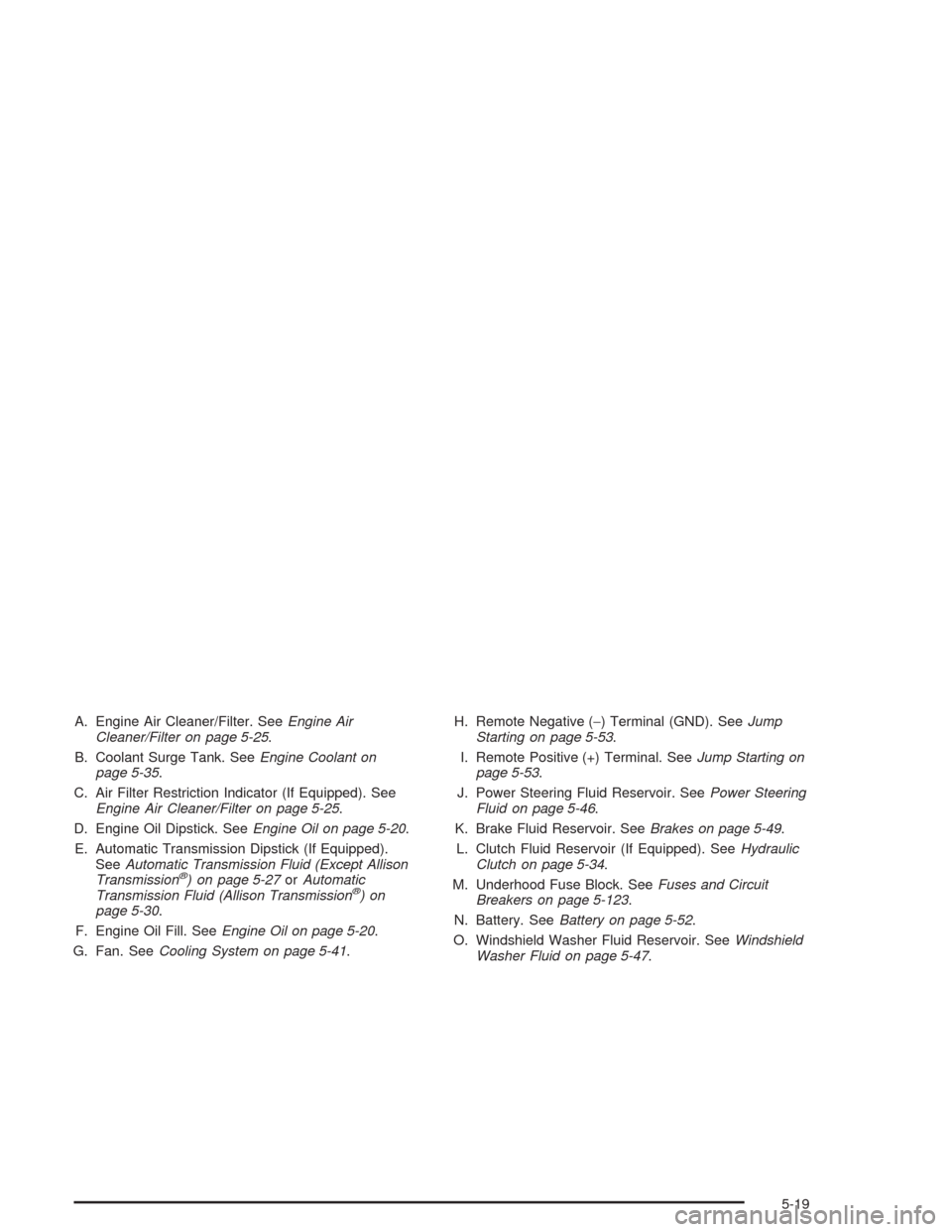
A. Engine Air Cleaner/Filter. SeeEngine Air
Cleaner/Filter on page 5-25.
B. Coolant Surge Tank. SeeEngine Coolant on
page 5-35.
C. Air Filter Restriction Indicator (If Equipped). See
Engine Air Cleaner/Filter on page 5-25.
D. Engine Oil Dipstick. SeeEngine Oil on page 5-20.
E. Automatic Transmission Dipstick (If Equipped).
SeeAutomatic Transmission Fluid (Except Allison
Transmission
®) on page 5-27orAutomatic
Transmission Fluid (Allison Transmission®)on
page 5-30.
F. Engine Oil Fill. SeeEngine Oil on page 5-20.
G. Fan. SeeCooling System on page 5-41.H. Remote Negative (−) Terminal (GND). SeeJump
Starting on page 5-53.
I. Remote Positive (+) Terminal. SeeJump Starting on
page 5-53.
J. Power Steering Fluid Reservoir. SeePower Steering
Fluid on page 5-46.
K. Brake Fluid Reservoir. SeeBrakes on page 5-49.
L. Clutch Fluid Reservoir (If Equipped). SeeHydraulic
Clutch on page 5-34.
M. Underhood Fuse Block. SeeFuses and Circuit
Breakers on page 5-123.
N. Battery. SeeBattery on page 5-52.
O. Windshield Washer Fluid Reservoir. SeeWindshield
Washer Fluid on page 5-47.
5-19
Page 421 of 584
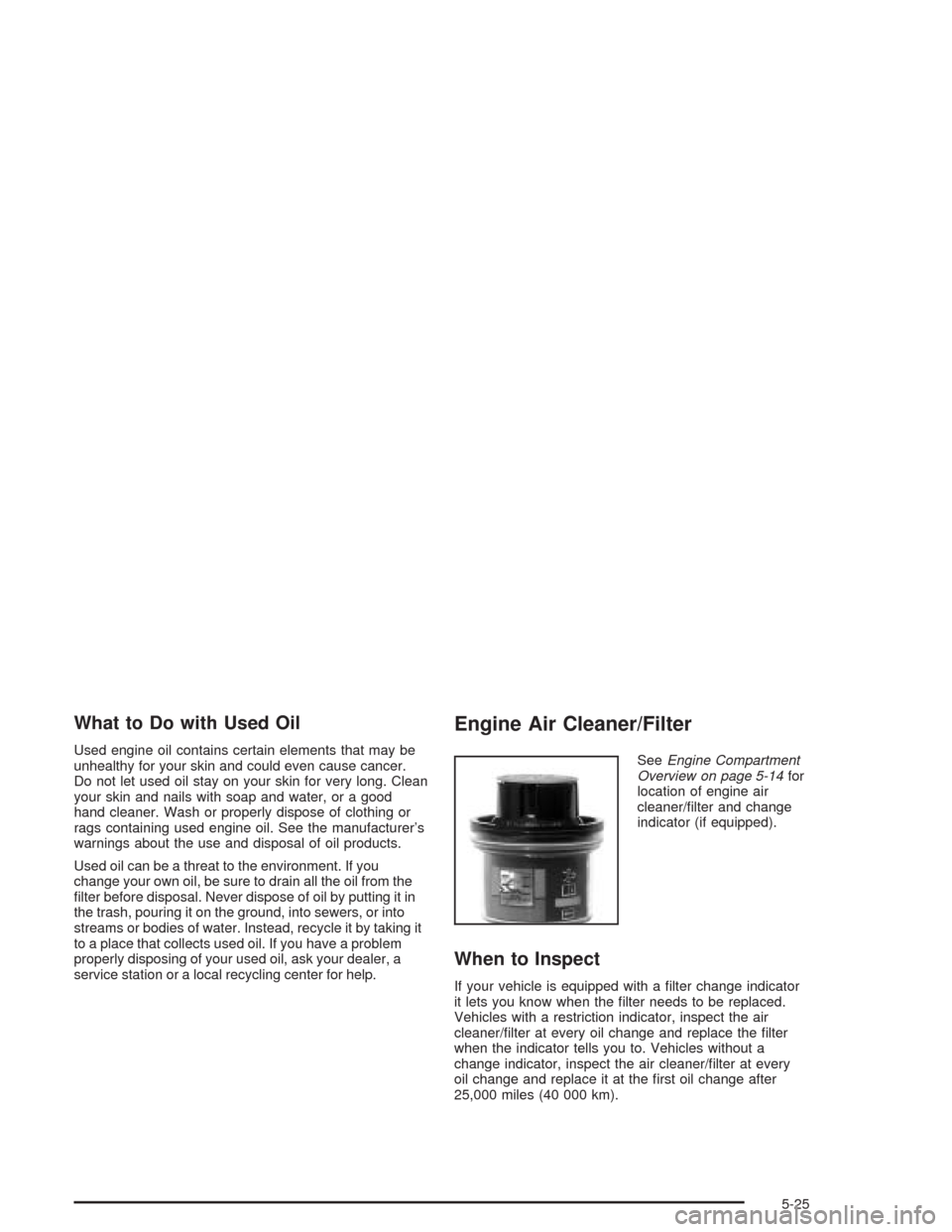
What to Do with Used Oil
Used engine oil contains certain elements that may be
unhealthy for your skin and could even cause cancer.
Do not let used oil stay on your skin for very long. Clean
your skin and nails with soap and water, or a good
hand cleaner. Wash or properly dispose of clothing or
rags containing used engine oil. See the manufacturer’s
warnings about the use and disposal of oil products.
Used oil can be a threat to the environment. If you
change your own oil, be sure to drain all the oil from the
�lter before disposal. Never dispose of oil by putting it in
the trash, pouring it on the ground, into sewers, or into
streams or bodies of water. Instead, recycle it by taking it
to a place that collects used oil. If you have a problem
properly disposing of your used oil, ask your dealer, a
service station or a local recycling center for help.
Engine Air Cleaner/Filter
SeeEngine Compartment
Overview on page 5-14for
location of engine air
cleaner/�lter and change
indicator (if equipped).
When to Inspect
If your vehicle is equipped with a �lter change indicator
it lets you know when the �lter needs to be replaced.
Vehicles with a restriction indicator, inspect the air
cleaner/�lter at every oil change and replace the �lter
when the indicator tells you to. Vehicles without a
change indicator, inspect the air cleaner/�lter at every
oil change and replace it at the �rst oil change after
25,000 miles (40 000 km).
5-25
Page 422 of 584
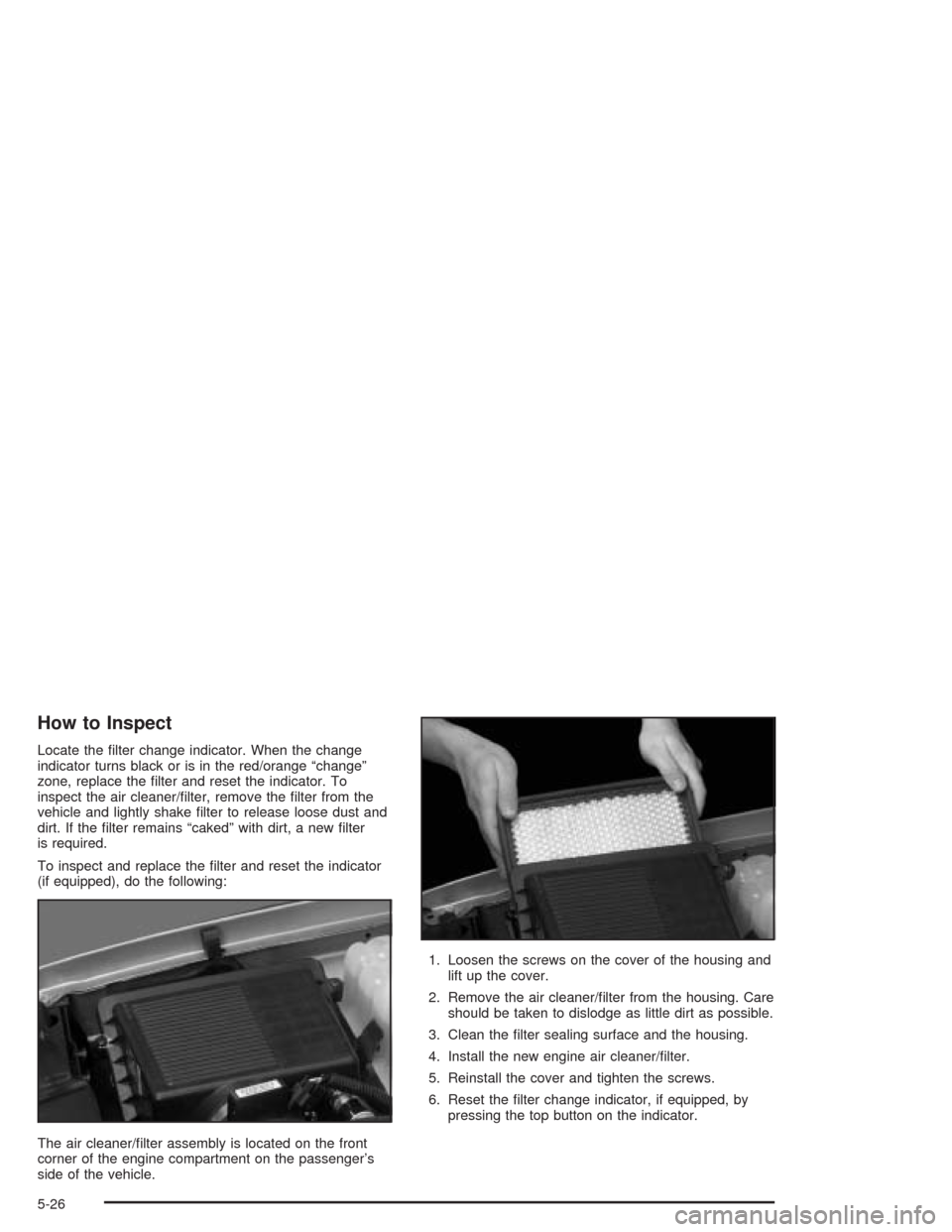
How to Inspect
Locate the �lter change indicator. When the change
indicator turns black or is in the red/orange “change”
zone, replace the �lter and reset the indicator. To
inspect the air cleaner/�lter, remove the �lter from the
vehicle and lightly shake �lter to release loose dust and
dirt. If the �lter remains “caked” with dirt, a new �lter
is required.
To inspect and replace the �lter and reset the indicator
(if equipped), do the following:
The air cleaner/�lter assembly is located on the front
corner of the engine compartment on the passenger’s
side of the vehicle.1. Loosen the screws on the cover of the housing and
lift up the cover.
2. Remove the air cleaner/�lter from the housing. Care
should be taken to dislodge as little dirt as possible.
3. Clean the �lter sealing surface and the housing.
4. Install the new engine air cleaner/�lter.
5. Reinstall the cover and tighten the screws.
6. Reset the �lter change indicator, if equipped, by
pressing the top button on the indicator.
5-26
Page 423 of 584

{CAUTION:
Operating the engine with the air cleaner/�lter
off can cause you or others to be burned.
The air cleaner not only cleans the air, it helps
to stop �ame if the engine back�res. If it is not
there and the engine back�res, you could be
burned. Do not drive with it off, and be careful
working on the engine with the air cleaner/
�lter off.
Notice:If the air cleaner/�lter is off, a back�re can
cause a damaging engine �re. And, dirt can
easily get into your engine, which will damage it.
Always have the air cleaner/�lter in place when you
are driving.
Automatic Transmission Fluid
(Except Allison Transmission
®)
When to Check and Change
A good time to check your automatic transmission �uid
level is when the engine oil is changed.
Change both the �uid and �lter every 50,000 miles
(83 000 km) if the vehicle’s GVWR is over 8,600 or if
the vehicle is mainly driven under one or more of
these conditions:
In heavy city traffic where the outside temperature
regularly reaches 90°F (32°C) or higher.
In hilly or mountainous terrain.
When doing frequent trailer towing.
Uses such as found in taxi, police or
delivery service.
If your vehicle’s GVWR is not over 8,600 and you do
not use your vehicle under any of these conditions,
change the �uid and �lter every 100,000 miles
(166 000 km).
SeeScheduled Maintenance on page 6-4.
5-27
Page 430 of 584

Then, follow these steps:
1. Remove the �ller plug.
2. Check that the lubricant level is up to the bottom of
the �ller plug hole.
3. If the �uid level is good, install the plug and be sure
it is fully seated. If the �uid level is low, add more
�uid as described in the next steps.How to Add Fluid
Here’s how to add �uid. Refer to the Maintenance
Schedule to determine what kind of �uid to use. See
Recommended Fluids and Lubricants on page 6-13.
1. Remove the �ller plug.
2. Add �uid at the �ller plug hole. Add only enough
�uid to bring the �uid level up to the bottom of the
�ller plug hole.
3. Install the �ller plug. Be sure the plug is
fully seated.
Hydraulic Clutch
The hydraulic clutch linkage in your vehicle is
self-adjusting. The clutch master cylinder reservoir is
�lled with hydraulic clutch �uid.
It is not necessary to regularly check clutch �uid unless
you suspect there is a leak in the system. Adding
�uid won’t correct a leak.
A �uid loss in this system could indicate a problem.
Have the system inspected and repaired. 5–speed for VORTEC™ 4300 V6 and
4800 V8 Engines Shown, Other Manual
Transmissions Similar
5-34
Page 431 of 584
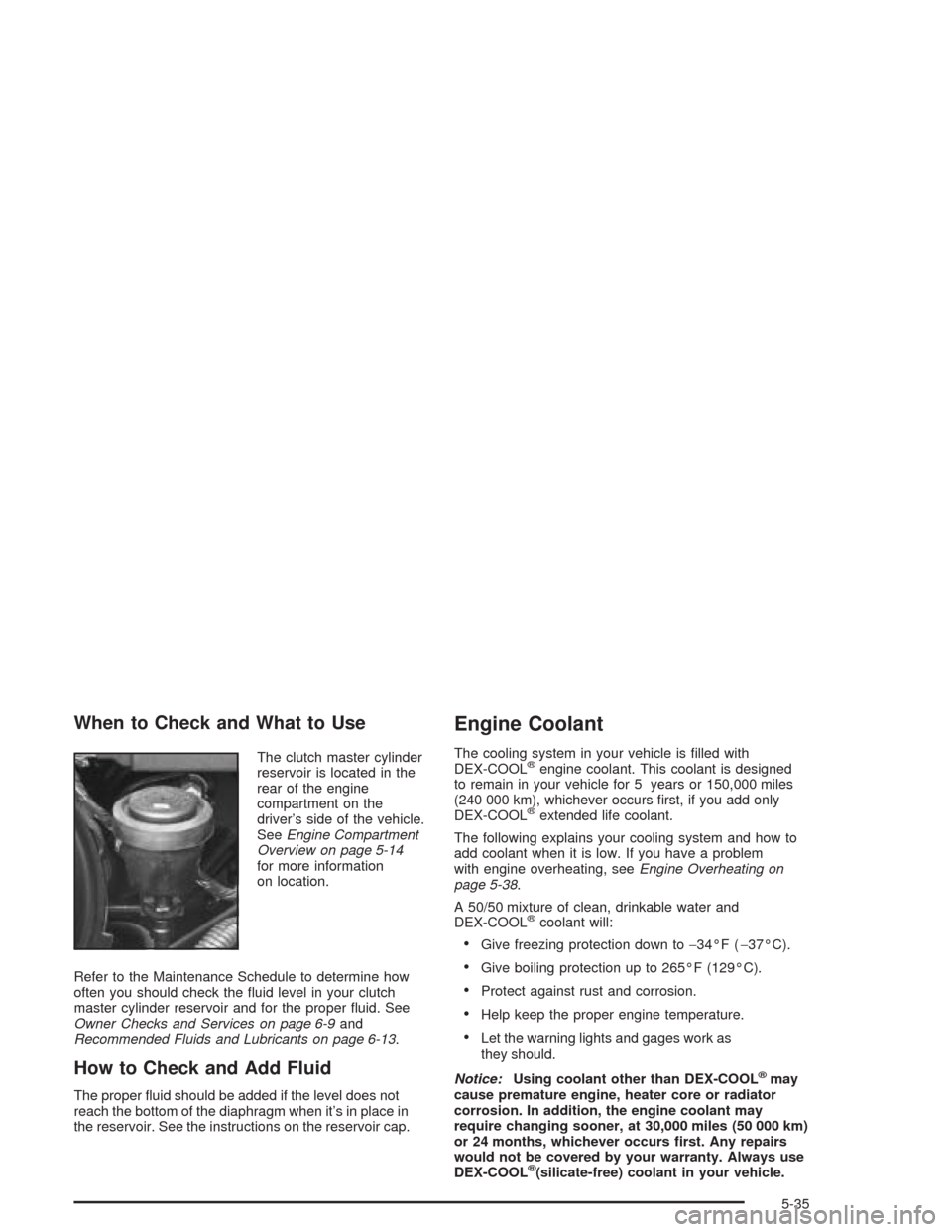
When to Check and What to Use
The clutch master cylinder
reservoir is located in the
rear of the engine
compartment on the
driver’s side of the vehicle.
SeeEngine Compartment
Overview on page 5-14
for more information
on location.
Refer to the Maintenance Schedule to determine how
often you should check the �uid level in your clutch
master cylinder reservoir and for the proper �uid. See
Owner Checks and Services on page 6-9and
Recommended Fluids and Lubricants on page 6-13.
How to Check and Add Fluid
The proper �uid should be added if the level does not
reach the bottom of the diaphragm when it’s in place in
the reservoir. See the instructions on the reservoir cap.
Engine Coolant
The cooling system in your vehicle is �lled with
DEX-COOL®engine coolant. This coolant is designed
to remain in your vehicle for 5 years or 150,000 miles
(240 000 km), whichever occurs �rst, if you add only
DEX-COOL
®extended life coolant.
The following explains your cooling system and how to
add coolant when it is low. If you have a problem
with engine overheating, seeEngine Overheating on
page 5-38.
A 50/50 mixture of clean, drinkable water and
DEX-COOL
®coolant will:
Give freezing protection down to−34°F (−37°C).
Give boiling protection up to 265°F (129°C).
Protect against rust and corrosion.
Help keep the proper engine temperature.
Let the warning lights and gages work as
they should.
Notice:Using coolant other than DEX-COOL
®may
cause premature engine, heater core or radiator
corrosion. In addition, the engine coolant may
require changing sooner, at 30,000 miles (50 000 km)
or 24 months, whichever occurs �rst. Any repairs
would not be covered by your warranty. Always use
DEX-COOL
®(silicate-free) coolant in your vehicle.
5-35
Page 432 of 584
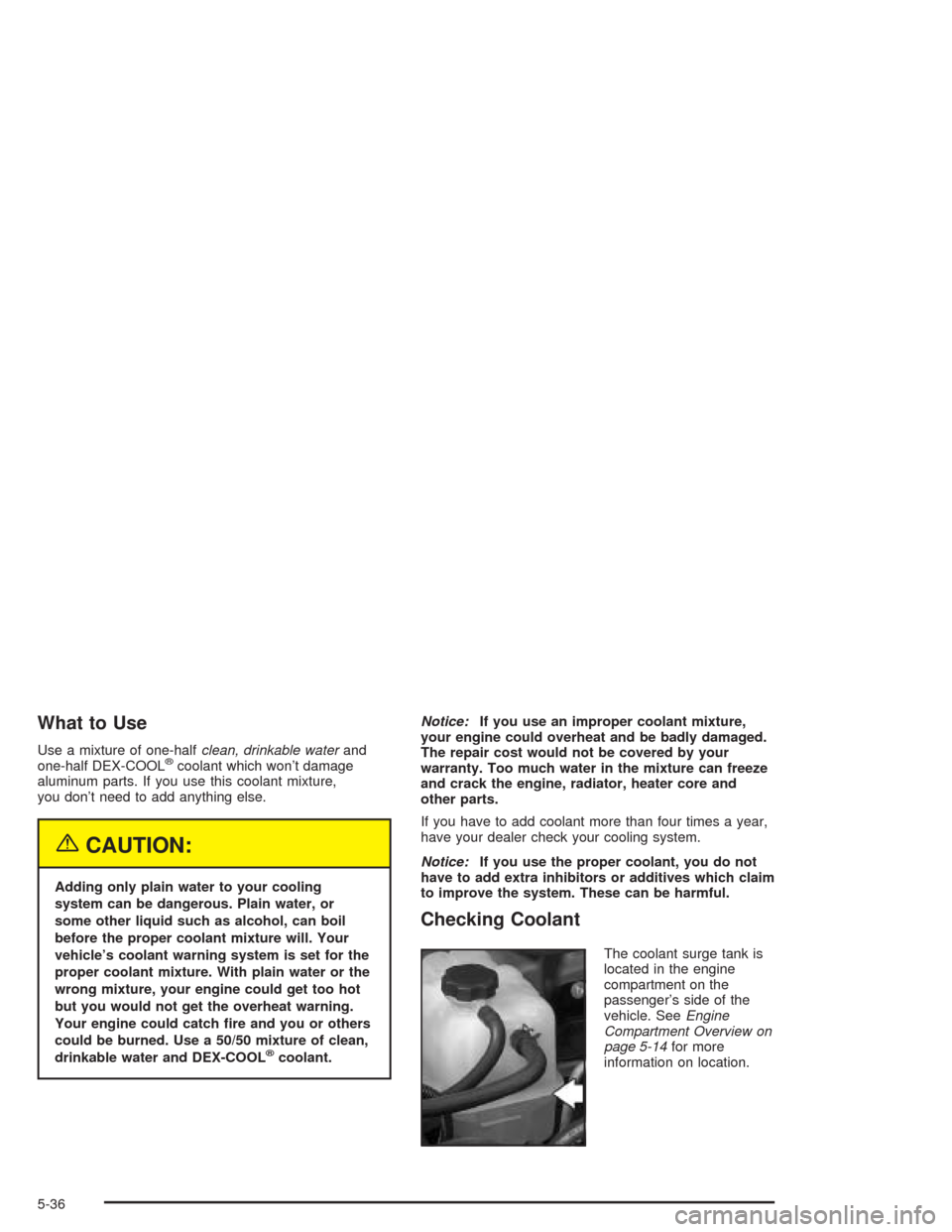
What to Use
Use a mixture of one-halfclean, drinkable waterand
one-half DEX-COOL®coolant which won’t damage
aluminum parts. If you use this coolant mixture,
you don’t need to add anything else.
{CAUTION:
Adding only plain water to your cooling
system can be dangerous. Plain water, or
some other liquid such as alcohol, can boil
before the proper coolant mixture will. Your
vehicle’s coolant warning system is set for the
proper coolant mixture. With plain water or the
wrong mixture, your engine could get too hot
but you would not get the overheat warning.
Your engine could catch �re and you or others
could be burned. Use a 50/50 mixture of clean,
drinkable water and DEX-COOL
®coolant.Notice:If you use an improper coolant mixture,
your engine could overheat and be badly damaged.
The repair cost would not be covered by your
warranty. Too much water in the mixture can freeze
and crack the engine, radiator, heater core and
other parts.
If you have to add coolant more than four times a year,
have your dealer check your cooling system.
Notice:If you use the proper coolant, you do not
have to add extra inhibitors or additives which claim
to improve the system. These can be harmful.
Checking Coolant
The coolant surge tank is
located in the engine
compartment on the
passenger’s side of the
vehicle. SeeEngine
Compartment Overview on
page 5-14for more
information on location.
5-36
Page 434 of 584
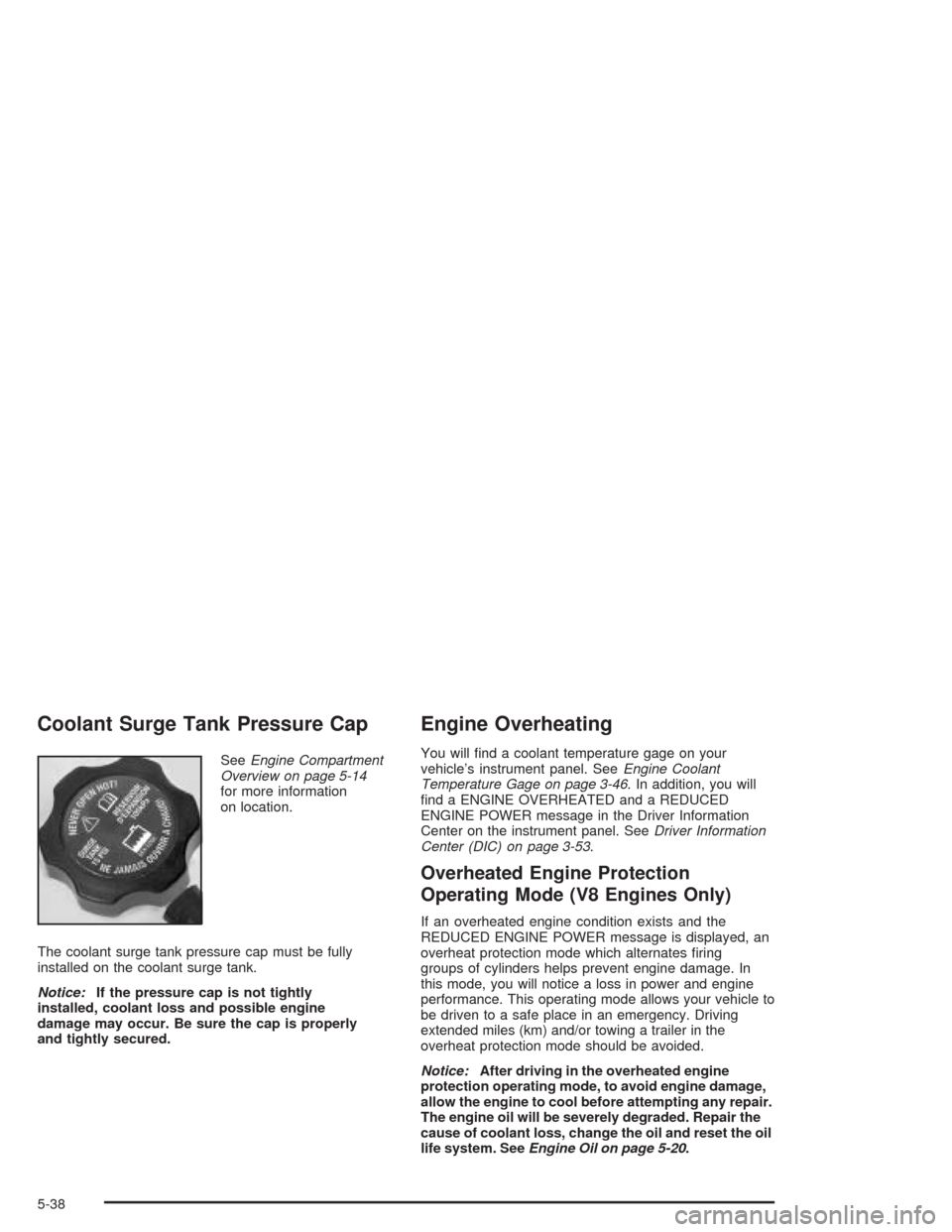
Coolant Surge Tank Pressure Cap
SeeEngine Compartment
Overview on page 5-14
for more information
on location.
The coolant surge tank pressure cap must be fully
installed on the coolant surge tank.
Notice:If the pressure cap is not tightly
installed, coolant loss and possible engine
damage may occur. Be sure the cap is properly
and tightly secured.
Engine Overheating
You will �nd a coolant temperature gage on your
vehicle’s instrument panel. SeeEngine Coolant
Temperature Gage on page 3-46. In addition, you will
�nd a ENGINE OVERHEATED and a REDUCED
ENGINE POWER message in the Driver Information
Center on the instrument panel. SeeDriver Information
Center (DIC) on page 3-53.
Overheated Engine Protection
Operating Mode (V8 Engines Only)
If an overheated engine condition exists and the
REDUCED ENGINE POWER message is displayed, an
overheat protection mode which alternates �ring
groups of cylinders helps prevent engine damage. In
this mode, you will notice a loss in power and engine
performance. This operating mode allows your vehicle to
be driven to a safe place in an emergency. Driving
extended miles (km) and/or towing a trailer in the
overheat protection mode should be avoided.
Notice:After driving in the overheated engine
protection operating mode, to avoid engine damage,
allow the engine to cool before attempting any repair.
The engine oil will be severely degraded. Repair the
cause of coolant loss, change the oil and reset the oil
life system. SeeEngine Oil on page 5-20.
5-38